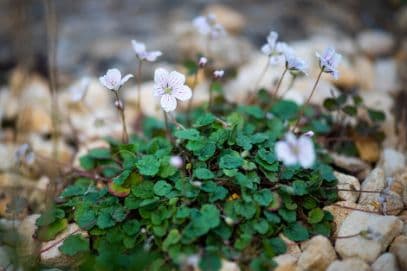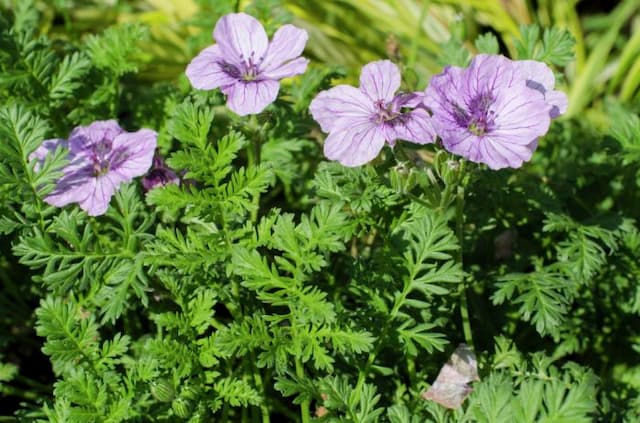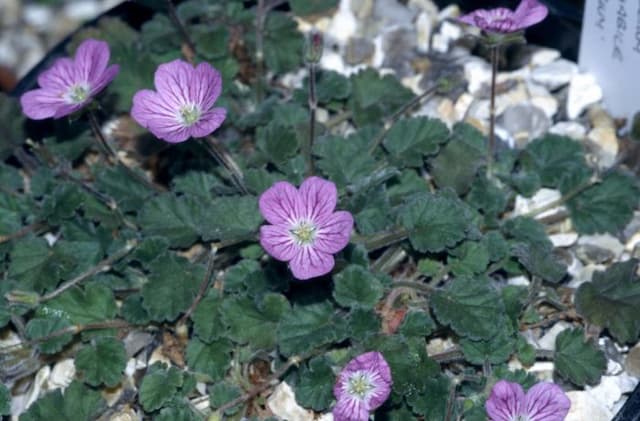Cranesbill Geranium 'Danny Boy'

ABOUT
Geranium 'Danny Boy' is a perennial plant with a vibrant and lush appearance. The leaves of 'Danny Boy' are deeply lobed, radiating out from the central stem, giving them a rounded yet slightly jagged look. They are typically a bright green color, which forms a lush backdrop to the flowers. The foliage may also showcase some reddish or purplish tints, especially as the temperatures cool. The flowers of 'Danny Boy' are the main attraction, standing out with their large, rounded clusters of blooms. Each flower cluster consists of numerous individual flowers. The petals are usually brightly colored, often in shades of pink, violet, or lavender, and are veined with contrasting or complementary hues that give them depth and dimension. The blooms come together in an umbrella-like fashion known as an inflorescence, which rises above the foliage on sturdy stems, presenting the flowers prominently when the plant is in bloom. This variety of geranium is known for its ornamental appeal and when in full bloom, the plant presents a showy and delightful display.
About this plant
 Names
NamesSynonyms
Cranesbill, Hardy Geranium, Geranium 'Danny Boy'
Common names
Pelargonium 'Danny Boy'
 Toxicity
ToxicityTo humans
Generally, geraniums, including the variety 'Danny Boy', are not considered highly toxic to humans. However, ingestion may cause minor symptoms such as nausea, vomiting, or diarrhea. It is always best to keep houseplants out of the reach of young children who may inadvertently ingest plant parts out of curiosity.
To pets
Geraniums can be toxic to pets, especially cats and dogs. If a pet ingests part of a geranium, they may exhibit symptoms such as vomiting, depression, anorexia, dermatitis, or ataxia. It is important to prevent your pets from chewing on or consuming this plant to avoid these potential consequences. If you suspect your pet has ingested geranium, contact your veterinarian.
 Characteristics
CharacteristicsLife cycle
Perennials
Foliage type
Deciduous
Color of leaves
Green
Flower color
Blue
Height
18 inches (45 cm)
Spread
24 inches (60 cm)
Plant type
Herb
Hardiness zones
5
Native area
Mediterranean
Benefits
 General Benefits
General Benefits- Attractive Blossoms: Produces vibrant and colorful flowers which add aesthetic appeal to gardens and landscapes.
- Easy to Grow: Known for being low-maintenance, making it suitable for gardeners of all skill levels.
- Drought Tolerant: Once established, it can withstand dry conditions, reducing the need for frequent watering.
- Pest Resistant: Naturally resists many common garden pests, minimizing the need for pesticides.
- Cold Hardy: Can survive in colder climates, making it versatile for different landscaping needs.
- Long Bloom Period: Flowers for an extended period, providing long-lasting color in the garden or patio.
- Attracts Pollinators: The blooms can attract bees, butterflies, and other beneficial pollinators to the garden.
- Ground Cover: Its growth habit makes it an excellent choice for ground cover, reducing weed growth and soil erosion.
- Versatile Usage: Suitable for borders, containers, and window boxes, offering various landscaping options.
- Heritage and Breeding: Often used in plant breeding to create new varieties and hybrids with desirable traits.
 Medical Properties
Medical PropertiesThis plant is not used for medical purposes.
 Air-purifying Qualities
Air-purifying QualitiesThis plant is not specifically known for air purifying qualities.
 Other Uses
Other Uses- Artistic inspiration: Geranium 'Danny Boy' can inspire artists by its striking blooms and can be featured in watercolor, oil paintings, or even botanical illustrations.
- Photography subject: The vivid colors and patterns of Geranium 'Danny Boy' can serve as an excellent subject for photographers looking to capture the beauty of nature.
- Plant dye: The petals of Geranium 'Danny Boy' could potentially be used to create natural dyes for fabric or paper, offering a range of pinkish hues.
- Educational tool: Educators might use Geranium 'Danny Boy' to teach students about plant biology, reproduction, and the importance of horticulture.
- Gardening workshops: This plant could be used in workshops to instruct on propagation techniques, such as cuttings, to new and experienced gardeners alike.
- Culinary presentation: While not consumed, leaves from the Geranium 'Danny Boy' could be used as a decorative element to add a touch of greenery on a serving platter.
- Companion planting: Geranium 'Danny Boy' can be used in companion planting to help deter pests from other plants in the garden due to its scent.
- Crafts: The leaves and flowers of Geranium 'Danny Boy' can be integrated into homemade potpourri or used in crafting for ornamentation purposes.
- Event decoration: The vibrant flowers can be used in flower arrangements or as decorative potted plants for various events and gatherings.
- Learning about pollinators: Geranium 'Danny Boy' can be used to study pollinator attraction and understand the plant-pollinator relationship in ecosystems.
Interesting Facts
 Feng Shui
Feng ShuiThe Geranium is not used in Feng Shui practice.
 Zodiac Sign Compitability
Zodiac Sign CompitabilityThe Geranium is not used in astrology practice.
 Plant Symbolism
Plant Symbolism- Unexpected Meeting - The 'Danny Boy' geranium cultivar, with its unique and striking colors, can symbolize serendipitous encounters or surprising meetings that bring joy into one's life.
- True Friendship - Geraniums in general have been associated with true friendship, suggesting this particular variety may symbolize the enduring bonds and deep connections between close friends.
- Comfort - The comforting and familiar shape of geranium flowers could represent the solace and comfort one finds in familiar things or people.
- Good Health - Geraniums are often connected to wishes for good health, possibly because they have historically been used in folk remedies and their presence brings a sense of well-being.
- Happiness - With its vibrant flower clusters, the 'Danny Boy' geranium might symbolize happiness and the simple joys in life.
 Water
WaterGeraniums, including the 'Danny Boy' variety, generally require thorough watering when the soil feels dry to the touch. It's best to water deeply but infrequently, about once a week, allowing the water to penetrate several inches into the soil. Give them approximately one gallon of water per plant for each watering session, ensuring you do not over-water to prevent root rot. During hotter weather, you might need to water them more often, especially if they are in containers. Always check the top inch of soil before watering to ensure it is dry, as overwatering can be detrimental.
 Light
LightGeraniums thrive in bright, indirect sunlight and do well in a spot that receives at least 4 to 6 hours of sunlight daily. The 'Danny Boy' geranium will perform best when it's placed in a location where it can get morning sunlight and partial shade in the afternoon, to protect it from the intense late-day sun. Avoid low-light conditions, as they can lead to leggy growth and fewer blooms.
 Temperature
TemperatureGeraniums prefer moderate temperatures and will flourish in conditions ranging between 65 and 70 degrees Fahrenheit during the day and down to 55 degrees Fahrenheit at night. They can survive in temperatures as low as 30 degrees Fahrenheit but must be protected from frost. Ideal growing conditions for 'Danny Boy' geraniums include warm days and cooler nights, ensuring healthy growth and bloom.
 Pruning
PruningPruning your 'Danny Boy' geranium promotes bushier growth and encourages more blooms. Prune them by removing dead flowers and leaves and cutting back leggy stems, ideally after a flowering cycle or in early spring. Pruning should be done every few weeks during the growing season to maintain shape and improve air circulation. The best time for a major prune is late winter or early spring, before new growth begins.
 Cleaning
CleaningAs needed
 Soil
SoilGeranium 'Danny Boy', commonly known as Cranesbill geranium, thrives best in well-draining soil enriched with organic matter. A mix of one part peat, one part perlite or coarse sand, and two parts garden soil creates an ideal environment. The soil pH should be slightly acidic to neutral, ranging from 5.8 to 7.0, to promote healthy growth and flowering.
 Repotting
RepottingCranesbill geraniums generally need repotting every two to three years to provide fresh nutrients and accommodate growth. It's best to repot them in the spring before new growth begins.
 Humidity & Misting
Humidity & MistingCranesbill geraniums prefer average home humidity levels. They are adaptable plants but perform best in environments with 40-60% humidity. Avoid overly humid conditions to prevent mold and disease.
 Suitable locations
Suitable locationsIndoor
Place in bright, indirect light with some direct sun.
Outdoor
Plant in partial sun, sheltered from wind.
Hardiness zone
4-8 USDA
 Life cycle
Life cycleThe life of the Geranium 'Danny Boy', commonly referred to as Cranesbill, begins with seed germination, when the right temperature and moisture conditions prompt the seed to sprout and develop a root system and shoot. The seedling stage follows, characterized by the growth of true leaves, which allow for photosynthesis and further development. As it transitions to the vegetative stage, the plant grows larger and develops a robust root system, stems, and multiple leaves, eventually reaching maturity and flowering. The flowering stage presents vibrant blooms, which is the plant's reproductive phase, where it attracts pollinators for sexual reproduction. Following pollination, seed development occurs, and once the seeds are mature, they are dispersed by various means, such as wind or animals. The plant may either die back in regions with cold winters, entering a period of dormancy, or it may continue to grow as a perennial, depending on the climate.
 Propogation
PropogationPropogation time
Spring-Early Summer
Geranium 'Danny Boy', commonly known as the Cranesbill Geranium, is most effectively propagated through division, which is best done in the spring or fall. To propagate by division, the gardener should carefully dig up the whole plant, making sure to keep a generous amount of soil around the roots. Once excavated, the clump can be gently pulled apart into smaller sections, each with its own set of roots and shoots. These sections should then be replanted promptly, ensuring that they are spaced adequately to allow for growth. It's critical to water the new divisions thoroughly after planting to help establish them in their new locations. This method of propagation not only creates new plants but also rejuvenates the parent plant by reducing overcrowding, which can improve its overall health and flowering.




![Cranesbill [Blue Sunrise]](/_next/image?url=https%3A%2F%2Fplants-admin.emdemapps.com%2Fimages%2Fplants%2F%2Fimages%2F604b638d45948.png&w=640&q=75)




